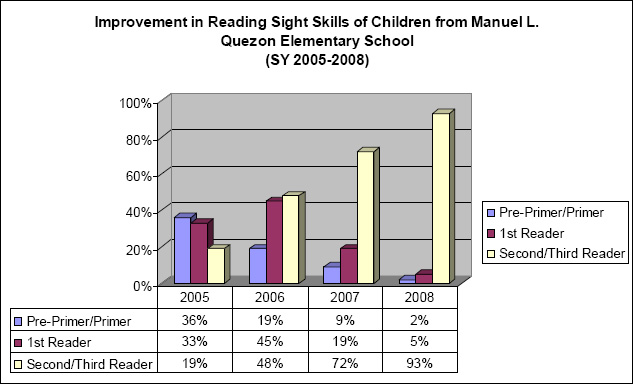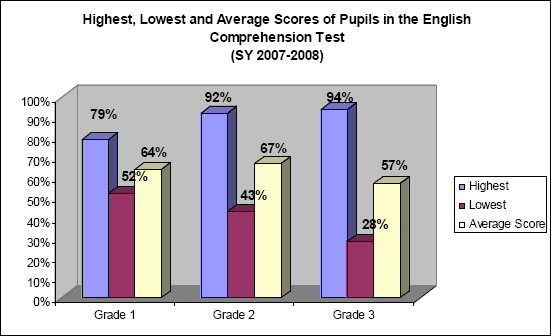3. Marks of Progress in Reading Proficiency
School Year-End Assessment Test
As in the past years, two tests were administered at the end of school year 2007-2008 to assess the progress of Grades One, Two and Three children in sight reading (decoding words) and in comprehension.
The site reading test or the DOLCH test is an internationally recognized test composed of more than 220 words. Each child is requested to read the words orally. His/ her reading level depends on the number of words read correctly. The test measures the capability of children to blend the sounds of the different consonants and vowels when reading a word.
The DOLCH test results showed that the program has significantly supported the capability of children to read. 9 out of 10 Grade 3 pupils are already reading at their appropriate reading level, compared to the 20% figure when they were in first grade. The program is also close to achieving its Zero Non-Reader goal – less than 10% of pupils (7% of pupils) are reading below par. This is quite a leap, considering that about 70% of these students could hardly read when they finished Grade One in SY 2004-2005.

Aside from the DOLCH test, an English Comprehension Test was administered to students. Reading comprehension is measured through a 30-item test composed of thinking exercises and stories. The questions are about simple recall and progress in difficulty. The children are asked to make inferences, generalize, interpret and perceive cause-and-effect relationships.
The mentioned test revealed that the children’s comprehension skills are quite high as well. On the average, grade 3 children obtained an average score of 57% in the comprehension test. This means they are able to answer 6 out of 10 questions on stories they read correctly. High achievers can answer 9 out of 10 comprehension questions correctly, while low performers can only answer 3 out of 10 questions correctly. This big disparity in scores could explain the dip in comprehension average scores from the previous year.

Analyzing the results, Principal Emir Velasquez surmised that the interventions made during the third year of the program helped high achievers do better (scores of high achievers rose by 2 percentage-points the following year) but did not support low performers in progressing to higher reading levels. She said grade three teachers, especially those handling the lower sections, need to work double-time in ensuring that children will not only develop good sight reading skills but also good comprehension skills by the end of the school year.
The year-end assessment test results celebrate the partnership of teachers, parents, the school administration officials of MLQES, Credit Suisse and Synergeia Foundation. The challenge for the community is to continue to strengthen critical thinking and comprehension skills of children and provide additional interventions (i.e. remedial reading) for 7% of its students who are still reading below par.




